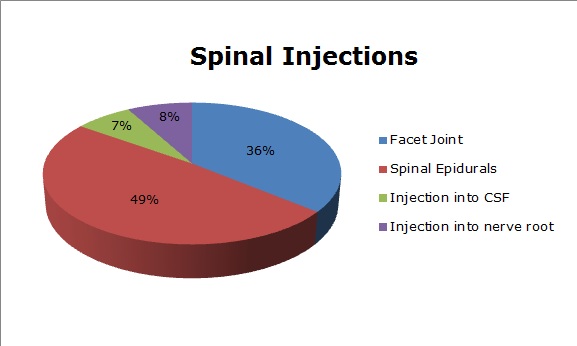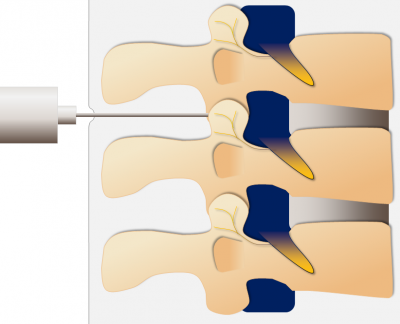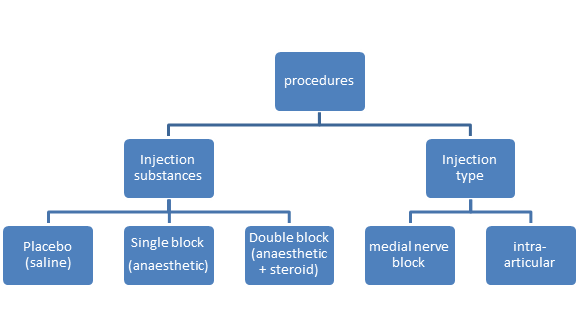Lumbar Facet Joint Injections: Difference between revisions
m (added self-made facet diagram) |
m (reduced facet pix size) |
||
| Line 38: | Line 38: | ||
The diagram below demonstrates an intra-articlar facet joint injection | The diagram below demonstrates an intra-articlar facet joint injection | ||
[[Image:Facet Joint Injection Diagram.png| | [[Image:Facet Joint Injection Diagram.png|thumb|center|400px|A facet joint injection]] | ||
<br> | <br> | ||
Revision as of 13:54, 2 January 2013
Original Editors - Georg Baker, Michelle harvey, Tommy Pearson, Joe Wakefield
Lead Editors - Your name will be added here if you are a lead editor on this page. Read more.
Introduction[edit | edit source]
LBP affects roughly 80% of the UK population and is the 2nd most common cause of long term-sickness from work [1]. A study released in 1999 revealed that the economic burden low back pain (LBP) produces onto the UK economy is £10,668 million, making it the most financially costly condition in the UK [2]. This figure is likely to have risen in recent years due to a larger number of LBP cases becoming chronic [3].
Spinal injections are one of the many varieties of treatments considered when an individual presents with chronic LBP. As well as a treatment method some spinal injections are also used as a diagnostic tool. An example of one such injection is facet joint injections; which in 2010-2011 made up 36% of all spinal injections (fig. 1.1) [4].
figure 1.1
The effectiveness of facet joint injections is largely unknown but despite this the procedure is still commonly performed by clinicians [5]. The Physiotherapy proffession are required to remain up to date with all available procedures each patient has aailable to them in treating their condition. Consequently, background knowledge regarding this treatment should be known by every clinician who regularly see’s LBP patients. Therefore this physiopedia page aims to use current literature to shine a light on the main areas surrounding this popular intervention, including:
1. The different procedures used for a facet joint injection
2. The risks facet joint injections cause
3. The variety of conditions that lead to facet joint injections being used
The effectiveness of facet joint injections coupled with some suggestions for future research/physiopedia pages will be included in the conclusion.
Background[edit | edit source]
Lumbar Facet Joint[edit | edit source]
Facet (zyagapophysial) joints are formed of the superior and inferior articulating processes of adjacent vertebra (Strayer, 2005[6]). They are classed as plane synovial joints (Palastanga, Field and Soames, 2006[7].). Within the Lumbar spine they are orientated in a vertical projection (Palastanga, Field and Soames, 2006[7]). The articular surfaces are covered by hyaline cartilage, surrounded by a thin fibrous joint capsule that contains a synovial membrane that secretes synovial fluid into the joint space (Peh,2009[8], Palastanga, Field and Soames,2006[7]). Free and encapsulated nerve endings supplied by the medial branches of the dorsi rami, innervate the facet joints (Sehgal et al, 2007[9]; Manchikanti et al,2004[10]).
Facet joints have been recognised as a possible source of chronic LBP since the early 1900's (Peh,2009[8], Manchikanti et al, 2004[10].
Facet Joint Injection
[edit | edit source]
Facet joint injections have two main purposes; one to relieve pain both short and long term and the other to be used conjunctively with physical examination as a diagnostic tool to determine whether the facet joint is the source of pain (Peh, 2009[8]; Manchikanti et al,2004[10];Sehgal et al, 2007[9] ).
The diagram below demonstrates an intra-articlar facet joint injection
Lumbar facet joint injections serve two main purposes;
1. To diagnose lumbar facet joints as a source of pain
2. As a therapeutic technique to help relieve the pain
Diagnostic facet joint injection[edit | edit source]
The following two-step response pattern is the current gold standard which is used to diagnosefacet joint syndrome, which may indicate a therapeutic facet joint injection.
1. Saline is injected causing distension of the problematic facet joint - this shouldreproduce/increase the patients’ pain.
2. Injection of local anaesthetic into the facet joint - this should reduce/relieve the patients’ pain.
Therapeutic facet joint injection[edit | edit source]
A local anaesthetic is initially given to decrease the nocioceptive signals in and around the facet joint. This is followed by the therapeutic injection which typically contains a mixture of a long acting steroid (e.g. Triamcinolone) and local anaesthesia (e.g. Bupivacaine).
The local anaesthetic will provide immediate pain relief, however the steroids may not start to take effect until 2-6 days post-injection. Pain relief following the injection varies.
A study showed that 22%-78% of patients experienced some form of pain relief at 2 weeks. However, long-term relief (3-6 months) varies between 28%-62% of patients, with 38% of patients experiencing no pain relief at 3-months follow-up, increasing to 44% at the 6-month follow-up[11].
Procedures
[edit | edit source]
Diagram 3.1 summarising facet injection types and substances
Risks
[edit | edit source]
In general this procedure carries low risk complications (Peh, 2009[8]; Cheng and Adbi, 2007[12]) and these risks are based on; single case studies, injection procedure reviews and hospital procedure information.
Side effects
[edit | edit source]
Side effects from the procedure include;
- Localised tenderness
- Bleeding
- Pain at the injection site (BUPA, 2009[13]; Sehgal et al, 2007[9] )
- Fainting (Sehgal et al, 2007[9])
- Paraesthesia (duration few minutes-hours) (Peh,2009[8])
Side effects from the steroids include;
- Fluid retention
- Weight gain
- High blood pressure
- Increase in blood sugar (mainly diabetics) (BUPA, 2009[13])
Complications
[edit | edit source]
- Unexpected allergic reaction to anaesthetic or steriod medication (BUPA,2009[13])
- Spondylodiscitis, (very rare) occured in a 78 year old male at L2-L4, this emphasised the importance of proper sterlisation before procedures (Falagas et al, 2006, Sehgal et al, 2007[9]).
- Septic arthritis (Cheng and Adbi, 2007[12]; Peh, 2009[8])
- Chemical meningism associated with an inadvertent dural puncture
- Excessive Bleeding (BUPA, 2009[13])
- Transient paraplegia and tetraplegia found in two separate case studies following cervical facet injections without image guidance (Peh,2009[8]; Sehgal et al, 2007[9])
Contraindications
[edit | edit source]
There were no definite contraindications; however this procedure was generally avoided in patients with;
- Systematic infections
- Skin infections over the injection site
- Bleeding disorders (Coagulopathy) or patients taking blood thinning medication
- Allergies to the medication or contrast agents used during the procedure
- Progressive neurological disorders that maybe masked by the procedure
- Pregnancy (due to exposure to radioactive material, eg x-ray)
- Uncontrolled diabetes and heart disease
(Peh, 2009[8]; MedCentral Health Central, 2012[14])
Implications for Treatment[edit | edit source]
Facet injections are general offered as a last resort after failure to improve following a period of conservative treatments, such as physiotherapy, drug therapy, bedrest, chiropractic manipulations and exercise [10].
These injections might be used in conditions were facet joints may become suspectible to becoming painful such as;
- Lumbar Facet Syndrome
- Spondylolisthesis
- Spondylolysis
- Rheumatoid Spondylitis (aka Ankylosing Spondylitis)
- Spinal Stenosis
- Trauma (for example road traffic accidents, sports or work with repetitive forceful hyperextentions
Peh,2009[8]; Harvey and Tanner, 1991[15];
Effectiveness of Facet Joint Injections[edit | edit source]
Conclusions [edit | edit source]
References[edit | edit source]
- ↑ Walker. B, 2000, The prevalence of low back pain: a systematic review, School of Public Health and Tropical Medicine, James Cook University, Townsville, Queensland, Australia, Journal of spinal disorders, Volume 13, Edition 3, Pages 205-217.
- ↑ Maniadakis. N, Gray. A, 1999, The economic burden of back pain in the UK Global Health Outcomes, Searle Division of Monsanto, P.O. Box 53, High Wycombe, Bucks HP12 4HL, UK, Journal of Pain, Volume 84, Edition 1, Pages 95-103.
- ↑ Freburger. J, Holmes. G, Agans. R, Jackman. A, Darter. J, Wallace. A, Castel. L, Kalsbeek. W, Carey. T, 2009, The rising prevalence of chronic low back pain, The Cecil G. Sheps Center for Health Services Research, The University of North Carolina at Chapel Hill, 725 Martin Luther King, Jr Blvd, Chapel Hill, NC, Archives of internal medicine, Volume 169, Edition 3, Pages 251-258
- ↑ NHS Hospital Episode Statistics, 2011. main Procedures and Interventions: Outpatient Statistics[excel]Available at: &amp;amp;amp;amp;amp;amp;lt;http://www.hesonline.nhs.uk&amp;amp;amp;amp;amp;amp;gt; [Accessed 20 November 2012]
- ↑ Eckel. T, 2004, Facet Joint Injections, Department of radiology, Lewis-Gale medical centre, 1900 Electric road, Salem, Virginia, USA, Journal of spinal pain, Volume 21, Edition 1, Pages 123-129
- ↑ Strayer,A., 2005. Lumbar Spine: Common Pathology and Interventions. The Journal of Neuroscience Nursing. 37(4) pp 181-193.
- ↑ 7.0 7.1 7.2 Palastanga,N.,Field,D.,Soames,R.,2006. Anatomy and Human Movement: Structure and Function. Butterworth Heinemann Elsevier:London
- ↑ 8.0 8.1 8.2 8.3 8.4 8.5 8.6 8.7 8.8 Peh,W.C.G., 2009. Image-guided Facet Joint Injection. [online] Available at:&amp;amp;amp;amp;amp;amp;amp;amp;amp;amp;amp;amp;amp;amp;amp;amp;amp;amp;lt; http://www.ncbi.nlm.nih.gov/pmc/articles/PMC3107686/pdf/biij-07-e4.pdf&amp;amp;amp;amp;amp;amp;amp;amp;amp;amp;amp;amp;amp;amp;amp;amp;amp;amp;gt; [Accessed 27 December 2012]
- ↑ 9.0 9.1 9.2 9.3 9.4 9.5 Sehgal,N., Dunbar,E.E., Shah,R.V., Colson,J., 2007. Systematic Review of Diagnostic Utility of Facet (Zygopophysial) Joint Injections In Chronic Spinal Pain: An Update. Journal of Pain Physician [online] Available at:&amp;amp;amp;amp;amp;amp;amp;lt; http://www.painphysicianjournal.com/2007/january/2007%3B10%3B213-228.pdf&amp;amp;amp;amp;amp;amp;amp;gt; [Accessed 29 Nov 2012].
- ↑ 10.0 10.1 10.2 10.3 Manchikanti, L., Boswell,M.V., Singh,V., Pampati,V., Damron,K.S., Beyer,C.D., 2004. Prevalence of Facet Joint Pain in Chronic Spinal Pain of Cervical, Thoracic, and Lumbar Regions, [online] Available at:&amp;amp;amp;amp;amp;amp;amp;amp;amp;amp;amp;amp;amp;amp;amp;amp;lt; http://www.biomedcentral.com/content/pdf/1471-2474-5-15.pdf&amp;amp;amp;amp;amp;amp;amp;amp;amp;amp;amp;amp;amp;amp;amp;amp;gt; [Accessed 27 December 2012].
- ↑ Lynch, M. and Taylor, J. (1986) Facet joint injection for low back pain: a clinical study. Journal of Bone and Joint Surgery, British Volume 68(1): pp.138-141.
- ↑ 12.0 12.1 Cheng,J., Adbi,S.A., 2007. Complications of Joint, Tendon and Muscle Injections. National Institutes of Health. [online] Available at:&amp;amp;amp;amp;amp;amp;amp;amp;lt; http://www.ncbi.nlm.nih.gov/pmc/articles/PMC2084363/pdf/nihms27149.pdf&amp;amp;amp;amp;amp;amp;amp;amp;gt; [Accessed 28 December 2012]
- ↑ 13.0 13.1 13.2 13.3 BUPA,2009. Facet Joint Infection. [online] Available at:&amp;amp;amp;amp;amp;amp;amp;lt; http://www.bupa.co.nz/fact_sheets/Factsheet.aspx?fs=cnt_facet_joint_injections.html&amp;amp;amp;amp;amp;amp;amp;gt; [Accessed 30 December 2012]
- ↑ MedCentral Health System, 2012. Facet Injections. [online] Available at&amp;amp;amp;amp;amp;amp;amp;lt; http://www.medcentral.org/Main/FacetInjections.aspx&amp;amp;amp;amp;amp;amp;amp;gt; [Accessed 30 December 2012].
- ↑ Harvey,J., Tanner, S., 1991. Low Back Pain in Young Athletes. Journal of Sports Medicine. 12(6) pp.394-406









